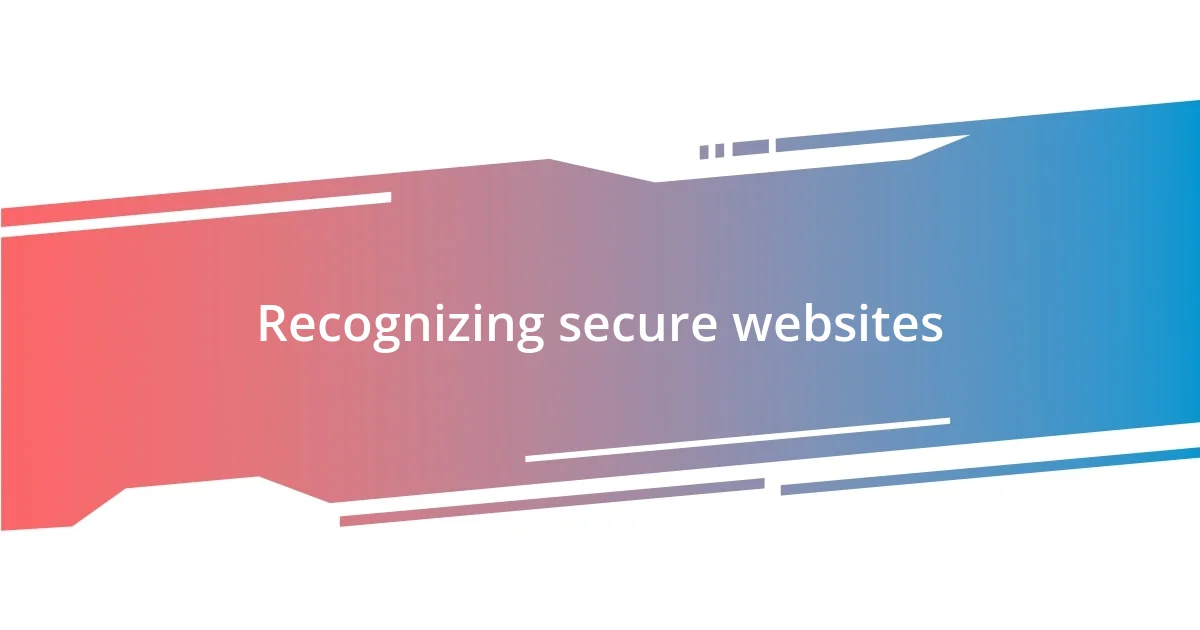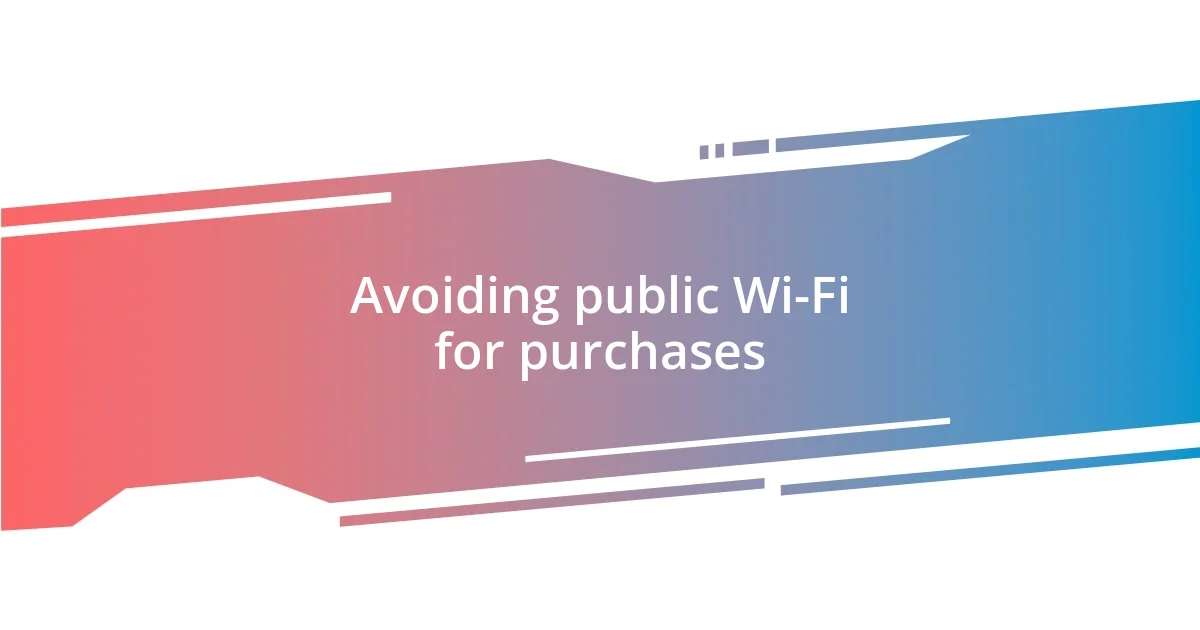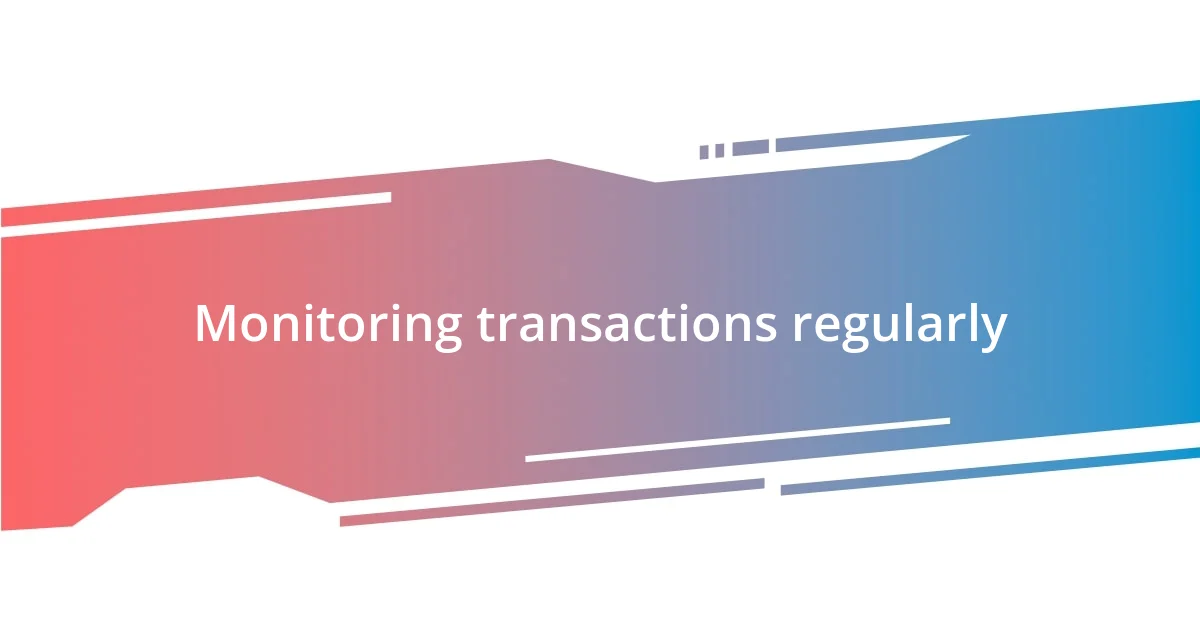Key takeaways:
- Look for “HTTPS” in URLs and check for padlock icons to ensure websites are secure before making purchases.
- Implement two-factor authentication (2FA) and use strong, unique passwords or passphrases to enhance account security.
- Monitor transactions regularly and report any suspicious activity immediately to protect against fraud.

Understanding secure online shopping
When I think about secure online shopping, I often recall that nerve-wracking moment I realized I had entered my credit card information on a sketchy website. Have you ever felt that sinking feeling in your stomach when you’re unsure if a website is safe? It’s crucial to look for signs like HTTPS in the URL, as it signifies that the site encrypts your data, adding an extra layer of protection.
I’ve learned firsthand that using well-known payment methods, like PayPal or digital wallets, can enhance your security. There was a time when I felt hesitant about using these methods, fearing they were too impersonal. But then, I realized they offer an additional shield because your financial information isn’t directly shared with the merchant. Don’t you find it comforting to have that kind of safety net?
Understanding secure online shopping isn’t just about technology; it’s also about being aware of red flags. For instance, if a deal seems too good to be true, it probably is. I remember once being lured by a flash sale that was nearly half the price of retail. Thankfully, I paused and researched the site, uncovering it as a scam. So, what can you do to protect yourself? Trust your instincts and always prioritize your safety.

Recognizing secure websites
When I browse for products online, the first thing I do is check for that reassuring “HTTPS” in the website’s URL. I remember hopping onto a new online store filled with beautiful shoes. Just as I was about to enter my details, I noticed the lack of HTTPS, and I felt my heart race—not in excitement but in fear. That was my cue to back off. Secure websites utilize HTTPS to encrypt data, making it difficult for hackers to intercept sensitive information.
Here are some key signs that indicate a website is secure:
– Look for HTTPS: Make sure the URL starts with “HTTPS” and not just “HTTP.”
– Check for a padlock icon: A padlock icon next to the URL signifies a secure connection.
– Investigate the domain name: Be wary of unusual or misspelled domain names—they can be red flags.
– Read reviews: Look up customer reviews and ratings on third-party sites to see others’ experiences.
– Evaluate contact information: Legitimate sites provide clear contact information, including addresses and customer service options.
Being vigilant means protecting yourself from possible threats. Trust me, it’s worth the extra few seconds to ensure you’re shopping on a secure website.

Using strong passwords effectively
Using strong passwords is one of the simplest yet most effective ways to safeguard your online shopping experience. I remember a time when I used a simple password for various accounts, and one day I received a notification about a login attempt from a location far from mine. Panic surged through me—was my information compromised? Since then, I’ve made it a priority to create unique, complex passwords for each of my accounts. It not only offers safety but also gives me peace of mind knowing that I’m taking proactive steps to protect myself.
The ideal strong password typically consists of a mix of upper and lower-case letters, numbers, and special characters. I’ve found that using a passphrase, which is a series of random words or a sentence, makes it easier to remember while also being hard to guess. For instance, instead of “password123,” I might use “RedFrog!Dances@Dawn72”, which creates a memorable yet secure combination. Have you tried using passphrases? They can be a game-changer!
Here’s a brief comparison of password strategies to illustrate their effectiveness:
| Password Strategy | Effectiveness |
|---|---|
| Simple Passwords (e.g., “123456”) | Very Low |
| Complex Passwords (e.g., “A1b2C3!@#”) | Moderate |
| Passphrases (e.g., “RedFrog!Dances@Dawn72”) | High |
| Password Managers | Very High |

Implementing two-factor authentication
Implementing two-factor authentication (2FA) has become a crucial step in securing my online purchases. I remember the first time I enabled it on my favorite shopping website. It felt like putting an extra lock on my front door. Every time I attempted to log in, a quick code was sent to my phone—a small but powerful safeguard against any unauthorized access. Have you considered how much safer you’d feel knowing there’s an added layer of protection?
There are times when I’ve felt a bit annoyed by the extra steps 2FA requires, especially during late-night shopping sprees when I just want to make that impulse buy. But I’ve learned that those few moments are well worth it. After all, if it means keeping my personal details and payment information secure from prying eyes, I’m all for it. Plus, many sites offer various methods for 2FA, like text messages or authenticator apps, so you can choose what works best for you. I personally favor an authenticator app because it’s convenient and adds an extra layer of security.
Situations where I forgot my phone or had to wait for a text code were frustrating, but they reminded me that security is paramount. Just the other day, I was making a purchase, and as soon as I entered the verification code, I felt a rush of relief. It was like a virtual high-five reminding me that I was taking charge of my online safety. Isn’t it reassuring to know that implementing 2FA can significantly lower your risk of falling victim to scams?

Avoiding public Wi-Fi for purchases
When it comes to making online purchases, I always steer clear of public Wi-Fi networks. I can’t tell you how many times I’ve seen people casually shopping at a café, completely oblivious to the fact that public Wi-Fi can be a hacker’s playground. Just imagine having your credit card information intercepted while enjoying a latte! It’s a risk I simply choose not to take.
Once, while traveling, I found myself at an airport with scant options for a secure connection. I had intended to buy a gift online but decided against it when I realized the Wi-Fi was unsecured. Instead, I saved the shopping for when I got home, where I knew I’d have a strong and protected connection. It wasn’t worth the stress—and possibly the heartache—of dealing with fraud later.
I often reflect on how easy it is to be tempted by convenience, but taking a moment to connect with private, secure networks makes all the difference. Have you found yourself in a similar situation? Maybe you’ve hesitated to make a purchase while in a crowded place, too. I would recommend using mobile data whenever possible for transactions; it adds that much-needed layer of security. Why risk it when your safety matters more?

Monitoring transactions regularly
Monitoring my transactions regularly has become a non-negotiable habit in my online shopping routine. I vividly recall the first time I discovered an unfamiliar charge on my bank statement. It sent a jolt of panic through me—was it a mistake, or had I been a victim of fraud? Since then, I’ve made checking my accounts a weekly ritual, like a mini security check-up, and it feels empowering. Have you ever thought about how much peace of mind this simple action can provide?
I often find myself scrutinizing each transaction for anything out of the ordinary. You’d be surprised at how easy it is to overlook small details, especially when you’re shopping online frequently. Just last month, I noticed a recurring subscription I hadn’t authorized. It was frustrating, but catching it early allowed me to dispute the charge before things escalated. Regular monitoring not only helps protect my finances, but it also keeps me in the loop about my spending habits. What about your spending habits? Could a closer look lead to valuable insights?
Each time I sit down to review my transactions, it also serves as a moment of reflection. It’s an opportunity to consider whether those impulse buys were worth it. I always ask myself: did that new gadget truly bring me joy, or was it just a fleeting thrill? This practice not only safeguards my wallet but also allows me to make more mindful purchasing decisions moving forward. In a world where online shopping is as easy as a click, taking a moment to monitor transactions regularly truly goes a long way in ensuring my safety and satisfaction.

Reporting suspicious activities immediately
Reporting suspicious activities immediately is crucial in today’s online shopping landscape. The other day, I received an email that appeared to be from a retailer I often shop with, but something felt off. There was a strange urgency in the message, urging me to confirm my payment details. Trusting my instincts, I reported the email as phishing and contacted the retailer directly. It turned out to be a phishing attempt, and I felt a wave of relief knowing I had acted quickly.
Have you ever hesitated to report something that just didn’t sit right? I know I have. A few months ago, I noticed a pop-up ad while browsing that tried to entice me into a fake discount on a popular product. It looked so convincing at first glance! But instead of dismissing it as just another ad, I took a moment to report it. I couldn’t shake the thought that someone else might unwittingly fall for it. That little action made me feel like I was doing my part to keep the online shopping community safer.
We all have a responsibility to help protect one another in the digital marketplace. I remember hearing a story about a friend who ignored a suspicious transaction reflecting on their bank statement. It didn’t end well for them, leading to a long battle with their bank over unauthorized charges. I’ve learned that trusting one’s gut and reporting anything that raises red flags can save a lot of hassle later. So, the next time something feels off to you, ask yourself: is it worth the risk to wait?















